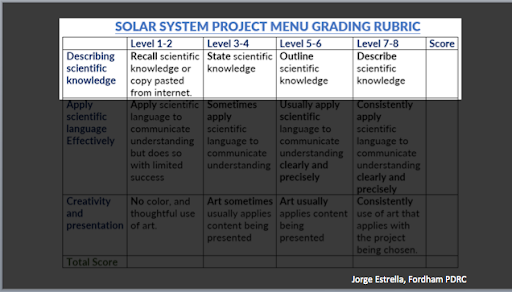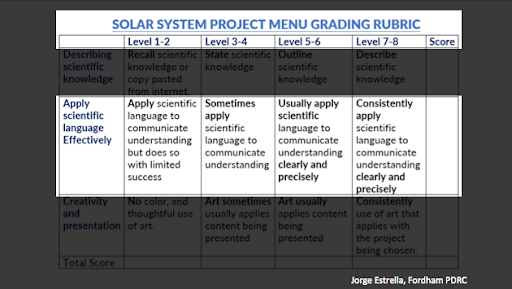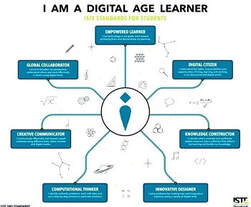 Before introducing their experts’ tips and tricks, both Jorge Estrella* and Deidre McElroy** posed three central questions: What is the message? Why is it important? How will I use PowerPoint, or Google tools to ensure that I present the message in a way that grabs the attention of all my students so that they have a clear understanding of the goal and can use the tools to achieve it? Knowing your audience, knowing who our students are is key to developing a good lesson presentation, one that is driven by clear outcomes, not by the technology itself. This message could not be clearer from ISTE. The International Society for Educational Technology defines today’s student as a Digital Age Learner (1). As illustrated in the poster, technology empowers students, makes them digital citizens, global collaborators, constructors of knowledge, creative communicators, innovative designers and computational thinkers. Technology is definitely a powerful learning tool, but savvy educators - as Jorge Estrella and Deirdre McElroy convey in their sessions, never use technology for technology’s sake. 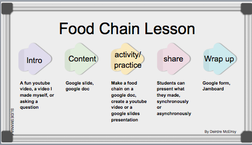 Deidre teaches her 3rd grade students in-person and online simultaneously. Her school is open for in-person attendance but some families have opted to keep their children at home. On February 24, during the first of a three-part series, Deidre illustrated her thinking process in developing a lesson using Google tools, all along inviting participants to think and share their own lesson objectives and tool ideas. 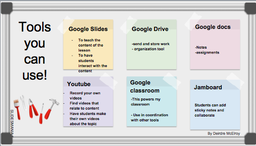 There are a variety of Google tools and as a Certified Google Educator, Deidre is proficient at all of them, but she is very thoughtful when it comes time to select the tools she will incorporate into a specific lesson. She shared that by having every one of her students in mind she selects tools that can best support each individual student. Thus, by selecting the right tools, she can tailor the instruction to meet the learning needs of her students. In addition, Google tools foster the personalization of instruction because it can involve students in creative tasks that may be based on personal interests and curiosity, e.g. Students creative work in small groups. 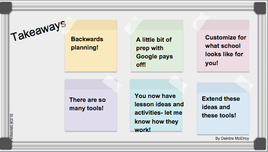 Deidre likes to start the lesson with a YouTube video that she may create herself. She uses the video to pose the essential questions in a format that grabs students’ attention and makes the language and content accessible. She then checks to ensure that students understood the goal of the lesson and are ready to learn. She also makes good use Google forms and Jamboard. Google forms are versatile, easy to create, and can be designed for very different purposes. She uses them often as exit tickets and formative assessments. Jamboard is her choice for group activities. Participants learned to apply Google tools, but as Deidre a tech savvy teacher emphasized, it is wise to always start with a solid existing lesson, and then consider the tools that can best support it; and always align the students’ learning goal with the learning assessment. 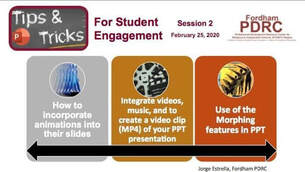 The session with Jorge Estrella on February 25th, was part two of this 3-part series, “Tricks and Tips with PowerPoint for Student Engagement”. In this session, participants enjoyed a full-hour of practice on techniques that go beyond the ‘basics’ and can immerse students in a full learning experience. In order to provide this level of student support and foster an environment where students become active learners, Jorge ‘deconstructed’ a lesson while articulating how each of the chosen presentation options aligned to the learning goals.
Jorge offered his participants the opportunity to contact him with individual questions so as to help them complete a lesson presentation that they can share on the last day of the series, Thursday March 25th.
The PDRC Team strongly encourages you to attend this session as well as Deirdre’s Part -2 on Wednesday, March 24th, even if you did not have the opportunity to be part of the previous webinars. By the end of the sessions, you will have a deeper understanding of the tools that make today’s teaching more exciting and powerful, tools that your students – digital age learners, will soon incorporate into their own learning toolbox. *Jorge Estrella, a member of the PDRC team has an extensive leadership experience has held positions as deputy superintendent, senior director of The Office of Teacher Effectiveness Implementation for the New York City Schools. He is a founding principal of the Manhattan MS for Scientific Inquiry, ranked in the top 10 percent of MS in New York City. ** Deidre McElroy is a certified Google Educator and classroom teacher at Holy Trinity School in Westfield, NJ. Dr. Adele Ellis, the principal of the school has a technology background, and she transformed the school into a wireless Internet environment and trained her staff in the use of Google tools a year before the world was hit by the covid19 pandemic. References:
0 Comments
Your comment will be posted after it is approved.
Leave a Reply. |
Archives
January 2024
Categories
All
|

